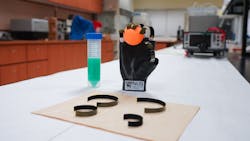The invention of a wooden robotic gripper can be a viable alternative to using traditional soft plastics or metal. It also upends traditional robotics design.
Researchers from the National University of Singapore (NUS), in collaboration with the Northeast Forest University, are working on a wooden robotic gripper that both withstands hot environments and maintains a tender touch. Their research was published online in the scientific journal Advanced Materials.
The team of researchers have shown that wood-based robotic grippers can overcome the limitations of traditional actuators and manipulators.
“Wood has excellent mechanical properties, natural deformation, available in large reserves, and is relatively cheap,” noted Tan Swee Ching, assistant professor and lead researcher from the Department of Materials Science and Engineering under the NUS College of Design and Engineering.
The wooden robotic gripper has the capacity to stretch and bend in response to moisture, thermal and light stimulation, and as Ching described it, has “good mechanical properties, is able to perform complex deformation, wide working temperature range, low manufacturing cost and is biocompatible.”
These are unique features that set wood apart from conventional plastic and metal alternatives. The researchers noted that the wooden gripper opens up when exposed to high humidity (above 95% RH), and closes tightly when the temperature of the surroundings increases beyond 70°C or when they are exposed to solar radiation.
A Gripper Constructed of Treated Wood
The wooden robotic gripper was constructed of 0.5-mm-thin Canadian maple.
But before it could be used in the gripper application, the wood was treated with sodium chloride to remove the lignin—a component found in the cell walls of plants. The researchers explained that large pores in the wood are filled with polypyrrole, a polymer that enables the material to absorb heat and light more easily.
READ MORE: Force Control Brings Dexterity and Sensitivity to Adaptive Robots
In addition, they formulated a nickel-based hygroscopic gel for moisture absorption. The gel was applied to one side of the wood, while a hydrophobic film was attached to the other side.
According to the research team, the wet-dry surface allows for quick absorption of water vapors on one side, and accelerates changes in the shape of the wooden gripper when exposed to high humidity.
The wood pieces were then shaped into a gripper at 70°C using special molds. When placed in an environment with 95% RH (that is, moisture stimulation), the hygroscopic gel took in moisture and the wooden gripper stretched and gradually opened outwards.
“When exposed to high ambient temperature of beyond 70°C (heat stimulation), the wooden gripper started to bend inwards and achieved maximum bending at 200°C,” explained Bai Lulu, a doctoral student at the NUS Department of Materials Science and Engineering and first author of the paper.
READ MORE: Soft Robotics: Bend Them, Shape Them, Any Way You Want Them
The wooden gripper was tested under different light intensities, with the hydrophobic film layer facing the light source. When the light illumination increased the gripper’s surface temperature to about 42°C, the moisture-absorbing gel started to lose water and the gripper began to bend inwards before achieving significant bending at about 57°C.
The researchers noted that the wooden gripper remained intact after 100 actuating cycles, demonstrating its stability and robustness for long-term use.
Overcoming Limitations of Traditional Actuators and Manipulators
The wooden gripper’s advanced performance was validated when picking up objects at high temperatures. “In our experiments, the wooden gripper successfully lifted a weight of 200 grams (equivalent to a can of soda) at around 170°C,” explained Chen Wenshuai, a professor at Northeast Forest University and co-corresponding author of the research paper.
He added that most actuators made using soft polymer are unable to achieve comparable performance. “Depending on the design, the wooden gripper could carry loads as high as 10,000 times the weight of the gripper,” said Wenshuai.
Improvements to Design Will Drive Fabrication and Cost
The research team will be looking at improving the performance of the wooden gripper, such as shortening the bending time from about two minutes currently, increasing the weight load it can carry, as well as gripping objects with different shapes and sizes. They are also exploring ways to reduce cost and to scale up the fabrication of the wooden gripper.
The research team stated that with further structural design and performance improvement, they hope to develop a design that can help firefighters carry out rescue operations.
READ MORE: Get a Grip: Robotic Grippers Help Automate the Food Industry



